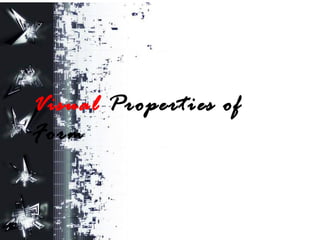
Form additive-subtractive
- 2. 1. SHAPE: The principle identifying characteristic of form; shape results from the specific configuration of a form’s surfaces and edges. 2. SIZE: -The real dimensions of form; it’s length, width, and depth - While these dimensions determine the proportions of form, it’s scale is determined by it’s size relative to other forms in it’s context. 3. COLOR: The hue, intensity, and tonal value of a form’s surface. -It distinguishes a form from it’s environment. -It affects the visual weight of a form. 4. TEXTURE: The surface characteristics of a form. -It affect the tactile and light- reflective qualities of a form’s surface.
- 3. 5. POSITION: A form’s location relative to it’s environment or visual field 6. ORIENTATION: A form’s position relative to the ground plane, the compass points or the person viewing the form. 7. VISUAL ENERTIA: the degree of concentration and stability of a form. -the visual inertia depends on geometry of a form, it’s orientation relative to the ground plane and our line of sight.
- 4. ALL OF THESE VISUAL PROPERTIES OF FORM ARE AFFECTED BY THE CONDITIONS UNDER WHICH WE VIEW THEM: 1. OUR PERSPECTIVE OR ANGLE OF VIEW. 2. OUR DISTANCE FROM THE FORM. 3. LIGHTING CONDITIONS. 4. THE VISUAL FIELD SURROUNDING THE FORM.
- 5. 1. SHAPE: refers to the edge contour of a plane. -it depends on the degree of visual contrast between the form and it’s background. In architecture we are concerned with the shapes of: • Planes (walls, floors, ceilings) that enclose the space. • Openings (windows and doors) • The silhouettes of the building form.
- 6. PRIMARY SHAPES 1. The Circle: a series of points arranged equally and balanced about a point. neutral stable unstable equilibrium Self centered dynamic Fixed in placestable
- 7. 2. The Triangle: a plane bounded by 3 sides and having 3 angles. It signifies stability. Resting on one side, identifies extreme stability.
- 8. 3. The Square: presents the pure and the rational. It’s static and neutral figure having no preferred direction. Resting on one side, identifies extreme stability. Dynamic when standing on one of it’s corners
- 9. REGULAR AND IRRIGULAR FORMS Regular forms are those whose parts and related to one another in a regular manner, they are stable and symmetrical about one or more axes. Irregular forms are those whose parts are dissimilar. They are asymmetrical, and more dynamic. -they can be regular forms form which irregular elements have been subtracted or an irregular composition of regular forms. Regular forms can be contained within irregular forms and irregular forms can be contained within regular forms
- 11. THE TRANSFORMATION OF FORM 1. Dimensional Transformation: by altering one or more of it’s dimensions.
- 12. 2. Subtraction: Subtractive forms still retain it’s identity depending on the portion of the subtraction A square L-shape of 2 rectangles Subtractive forms can be used to create entrances, private courtyard spaces or window openings
- 13. 2. Addition: An additive form is produced by the addition of another form to it’s volume The basic possibilities of two forms to group together are: Spatial tension: it requires that the two forms e relatively close to each other, or share a common visual trait such as shape, material, or color. Edge to edge contact: two forms share a common edge, and can pivot about that edge.
- 14. Face to face contact: it requires that two forms have flat, planar surfaces that are parallel to each other. Interlocking volumes: two forms interpenetrate each other’s space. These forms need not share any visual trait.
- 15. Additive forms can be characterized by their ability to grow and merge with other forms. It can be categorized according to the nature of the relationships that exist among 1. Centralized Consist of a number of secondary forms clustered about a dominant, central space Centralized forms require the visual dominance of a geometrically regular, centrally located form
- 16. 2. Linear It results from a proportional change in a form’s dimension or the arrangement of a series of forms along a line. It can be curvilinear to respond to conditions of the site such as topography, view, or vegetation. It can be used to front or define an edge of an exterior space, or define a plane of entry to the spaces behind it It can be manipulated to enclose space It can be oriented vertically to identify a point in space or it can act as an organizing element to which a variety of forms can be attached
- 17. 3. Radial forms It can grow into a network where several centers are linked by linear forms.
- 18. 4. Clustered forms A cluster organization groups it’s forms according to functional requirements of size, shape or proximity. It’s flexible enough to incorporate forms of various shapes, sizes, and orientation into the structure. It can consist of forms that are generally equivalent in size, shape, and function
- 19. 5. Grid forms It’s used to break the scale of a surface down into measurable units and give it an even texture
